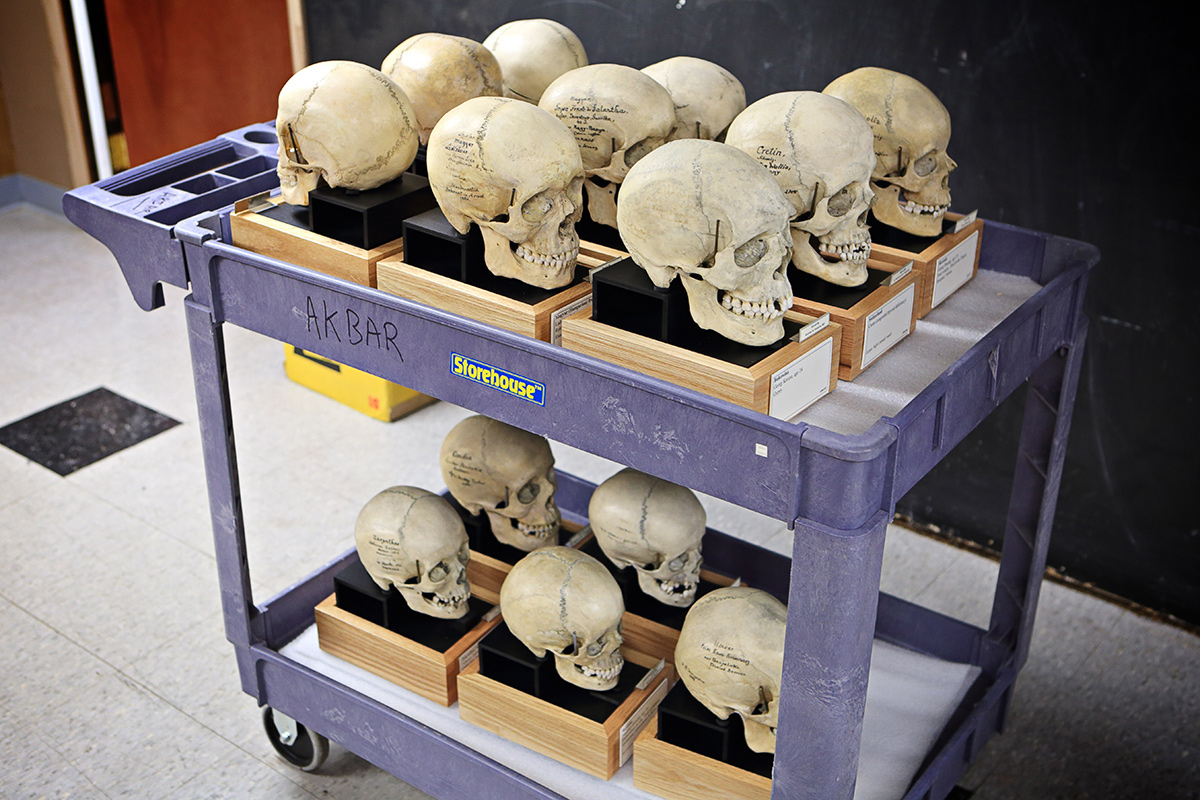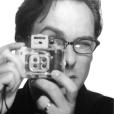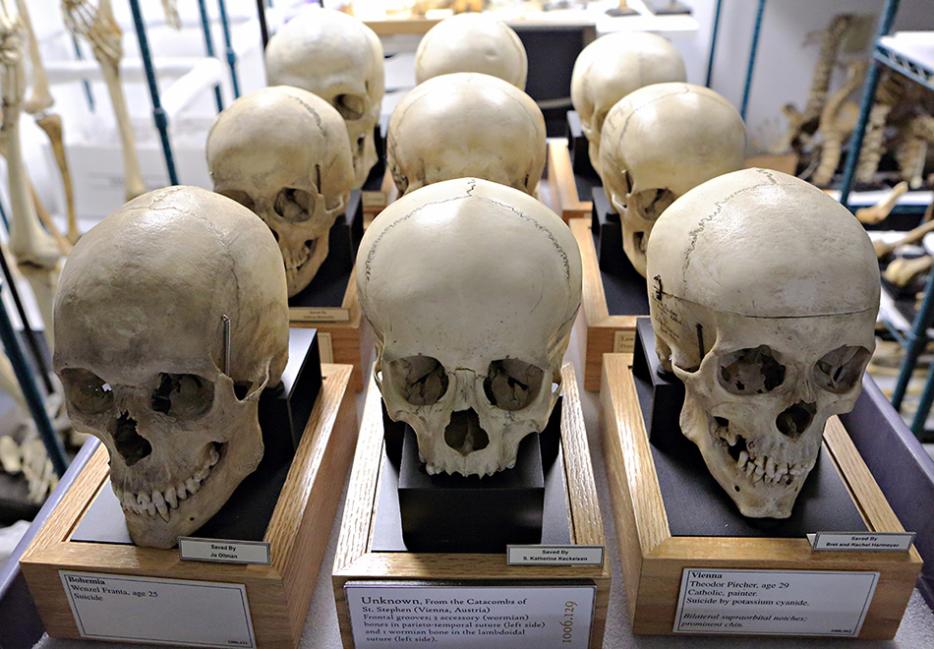The head on the table next to me had begun to reek.
There was a distinct tickle of unpleasantness when I first walked in that morning, but having spent almost four weeks total working in the “Bone Room,” located in the basement of the Mütter Museum in Philadelphia, I’d grown accustomed to myriad unusual and (usually) subtle scents. The Bone Room is filled with shelves containing specimens of all types—everything from skulls and bones (animal and human) to severed human feet covered with lacquered flesh, to a massive whale penis; I’d noticed many smells entering the atmosphere, becoming distinct, then melting back into the overall mustiness of the room. If ignored, these whiffs tended to go away.
But not this one. This head—at more than two hundred years old, though mainly bone, it still had enough reddish black, well, matter on it that I couldn’t really call it just a “skull”—had steadily grown more potent. I was also going to be in its company for the foreseeable future: former president Bill Clinton was speaking at a fundraiser in a ballroom upstairs. The agreement we’d reached with the Secret Service was for me to stay inside the Bone Room once Clinton arrived until he was out of the building, and we got an all-clear.
I’d been photographing the Mütter’s collection of human skulls for an ongoing project, titled Perfect Vessels, to explore ideas of “perfection,” and to emphasize a skull’s use as a container—both practically and mystically, during and after life. I would photograph one skull facing directly towards me, then mirror a single half, making it perfectly symmetrical. I’d worked with repetition and symmetry extensively in previous projects, and learned that as soon as you repeat a shape, no matter how irregular it is, the pair feels entirely balanced.

When at the Mütter, researching these sometimes bizarre histories, and seeing the devastating effects of mercifully bygone maladies, you can’t help but think about the lives that were so dramatically affected. It’s both powerful and heartbreaking to think of someone’s suffering (both from the illness, whether mental or physical, and the attempted cure) leading to states of health we now take for granted. There’s a nobility and grace in giving a life to something larger than yourself, but none of these lives were intended as gifts: people simply wanted what was bedeviling them to be sorted out. It’s a reminder that medicine—even as relatively sophisticated as it has become—has always been a grueling, incremental process. Many must perish in the same way until a common solution is worked out. This is still true today, as we must wait for a generational cycle to determine a potential (pharmaceutical or surgical) treatment’s efficacy.
It’s also remarkable to see how some “primitive” attempts at care remain in use today. We tend to bring up treatments like trephining and leeching as examples of how far medicine has progressed away from superstition and laughably crude solutions; when it comes to using those techniques to release malevolent spirits or keep the four humors in balance, fair enough. But removing a section of skull to ease swelling (craniotomy) is still performed in cases of extreme intracranial pressure. And leeches are still in use today: the anticoagulant hirudinin the leech’s saliva reduces clotting, keeping separated tissue alive—especially helpful when keeping organs and parts viable for reattachment, or during reconstructive and plastic surgery. (Robert Hicks, the Mütter Museum’s director, learned of these remarkable properties firsthand when he accidentally overfed one of his pet leeches, then couldn’t stop the bleeding.)
My consideration of these lives lived, and what they helped secure for us today is something that will strike me, punctum-like, at unexpected intervals. There are times when I get so lost in the work that noting the facts has become part of my daily routine as much as finding Akbar or Jeff loaded afresh each morning. Each day’s work involves the logging of names and events even before any vigilant handling of these fragile one-of-a-kind artifacts. I never want to risk over-confidence. After becoming absorbed in the technical and aesthetic matters of photography and lighting, it is a last reminder as I confirm the information of who each person was, what they did, what they valued, and what they suffered. I’m never far away from connecting the skull to specific facts of a life. And yet, the “object” aspects of these skulls can distance me from the fact that they were once part of someone’s body. Those aromatic remains I had to banish from my workspace were a tangible reminder that I’m working with remnants of an organic form.
Having now quadruple-checked that today’s information was accurate, I replaced the focusing screen, reset the lights, and finished off the batch of skulls. I texted to see if I missed an all-clear and got an almost immediate reply:
Nope. Could be awhile. They warned us that he likes to talk ;-)
Well, I’d had my eye on a few candidates within the Bone Room itself. Most of the skulls on the shelves had little or no information available; no names, just accession numbers written on paper tags looped around a thin section of bone, most often the jaw, if there was one. There were tiny, featherweight fetal skulls, skulls attached to articulated skeletons, skulls mounted to old-fashioned display stands, and parts of skulls that look like pottery sherds. Without names, these could have seemed even more at an archeological remove to me than those I had previously set aside. But thanks to today’s olfactory interlude, I was acutely aware of these having once been part of a human being. I gently set another onto the stage, peered into the viewfinder, into (reassuringly) empty eyes, and wondered: What was the story here?






